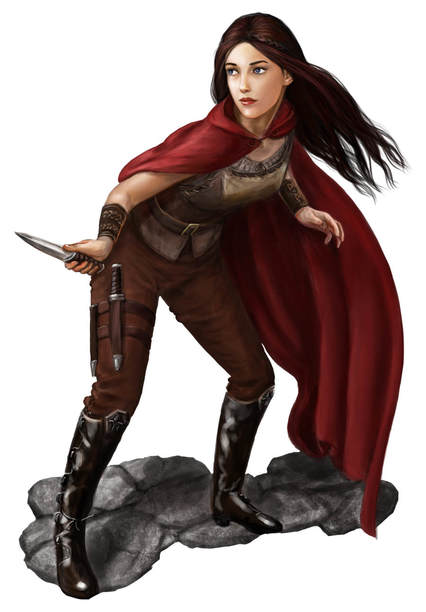 When you get to the heart of roleplaying, it’s all about the characters. Whether they are the stars of the show as Player Characters or supporting actors run by the Game Master, rich and believable characters are the key to the roleplaying experience. It is their story that draws you in, excites your mind, and makes you care about the fictional world you’re playing in. Savage Worlds provides an excellent framework to build characters but it is the elements beyond the stats and edge lists that really tell you who this person is. I put the following guidelines to good use when I created twenty original characters in four common genres (haunted west, modern horror, historical fantasy, and space opera) in Savage Characters, Volume 1 (available on DriveThruRPG.com). 1) Make An Impression Form a short scene in your mind as though you were watching a movie. This is the first time the audience will meet your character so think of how it might go. What characteristics are immediately noticeable: their hulking strength, head-turning beauty, easy smile, distracting talk, or haunted look? Do they shy away from contact or wade easily into the crowd? Do they move with the regal bearing brought on by years of tutoring and the right bloodlines, with the agile awareness of a veteran soldier, or with awkward stumbles as they adjust their spectacles? Is their speech flowery and intellectual or crude and street level? Does their accent betray their origins? Are they extroverted, wanting to join a celebration or more reticent, preferring to watch from out of the way? You can set the scene wherever people could logically meet your character for the first time. A tavern or bar is pretty good for this but you could also meet them where their job or role normally takes them: the halls of a noble’s court, the traveler’s roads, sanctuary of their temple, or a craftsman’s stall. Picture them in a situation where they are expected to act rather than be passive so you can get a better feel for them. Leverage this preparation when you introduce your character to your fellow players or when meeting an NPC for the first time. 2) Develop Connections Very few people live in isolation from the rest of society. In fact, it is often by our relationships with others that we discover ourselves and exhibit who we are for good or ill. No matter where a campaign might begin the characters have history up to that point. They have family, have friends and enemies, and live and work with dozens of others. While they begin to grapple with the Call to Adventure*, whose counsel would they seek? What favors would they call in? Who might make their life harder at the wrong moment? These connections give the player more to work with both in deciding her character’s actions/reactions and in knowing what resources they can leverage beyond what is on their personal equipment list. All sorts of information can be gathered to better face the challenges ahead. Obligations and commitments, with their connections, will try to hold our hero back, letting them naturally Refuse the Call* or be bold and strike out for adventure. 3) Get Hooked In Savage Characters, Volume 1, I created five different adventure hooks for each of the twenty characters so they could be easily used either as NPCs or as player characters. Each hook was aligned with a rank in the character’s development to show a progression of challenges. Some hooks tied together into logical sequences, almost like a micro-Plot Point for the character. Some hooks gave options to tie some of the characters together either as allies or antagonists. Hooks present the ingredients for a conflict but don’t demand a specific solution. The motivations and objectives of other characters should be clear as well as what might happen if the player character does nothing. Would their own goals become harder or be put in jeopardy? Would their allies or innocents be hurt? Would evil claim some triumph large or small? Give the character a clear reason to act and let the player devise just what those actions will be. If you're creating a player character, help your Game Master out. Try to think of adventurous situations your character might seek out or face. What threats, opportunities, or challenges would motivate your character to act? Would they pursue a treasure map, rumors of a village under attack, or a path to lost wonders? Providing hooks to your GM will make the game more enjoyable for everyone? There are many ways to develop characters for RPGs. I think these three can provide easy hints for inspiration at the table-side, which is where we all need it most. We suffer plenty of l'espirit de l'escalier in our daily lives so everything that can help you play the character you want in the moment is worth time during character creation. * See Joseph Campbell’s The Man with a Thousand Faces for an examination of the stages of heroic tales from around the world. Jim founded Dragonlaird Gaming Studios in 2005 as a channel for his original tabletop RPG work. He’s an accomplished freelance writer with Knights of the Dinner Table Magazine (as a columnist) from Kenzerco, Margaret Weis Productions (Serenity, Battlestar Galactica, Cortex), and many others. He published Savage Characters Volume 1 a couple years ago and has plans to release a series of Savage Adventures soon. You can find his website at www.dragonlairdgaming.com. Picture Reference: Artwork provided by author 25/11/2023 04:03:37 am
I appreciate you providing this fascinating topic on the three steps to developing a ferocious character. Which key has had the biggest influence on your professional or personal development?
Reply
Leave a Reply. |
All blog materials created and developed by the staff here at High Level Games Archives
April 2023
Categories
All
|
Proudly powered by Weebly



 RSS Feed
RSS Feed